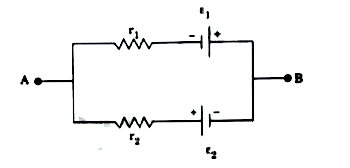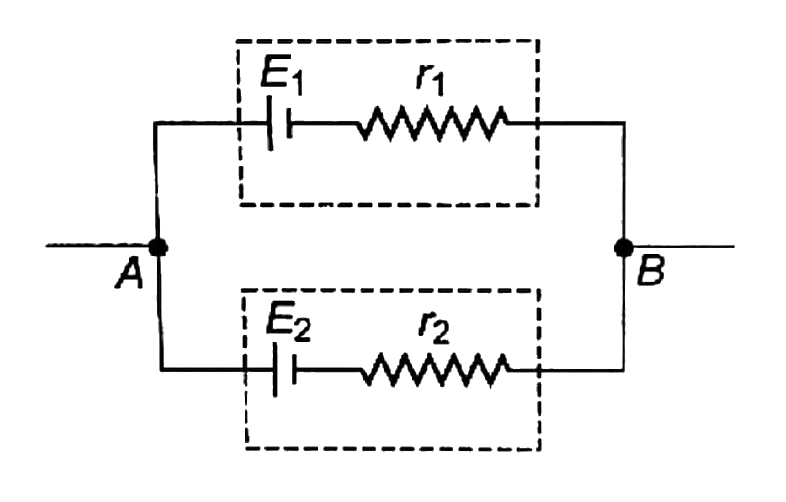A battery is combination of two or more cells. In the following figure , a single battery is represented in which two cells of emf ε1 and ε2 and internal resistance r1 and r2 respectively are connected.

The equivalent emf of this combination is :
ε1r1+ε2r2r1+r2
ε1r1−ε2r2r1+r2
ε1r2−ε2r1r1+r2
esπ1−ε2
Step by step video & image solution for A battery is combination of two or more cells. In the following figure , a single battery is represented in which two cells of emf epsi_1 and epsi_2 and internal resistance r_1 and r_2 respectively are connected. The equivalent emf of this combination is : by Physics experts to help you in doubts & scoring excellent marks in Class 12 exams.
Updated on:21/07/2023Topper's Solved these Questions
- QUESTION PAPER 2022 TERM 1 SET 2BOOK - XII BOARDS PREVIOUS YEARCHAPTER - QUESTION PAPER 2022 TERM 1 SET 2EXERCISE - SECTION B
24 Videos
- QUESTION PAPER 2022 TERM 1 SET 1BOOK - XII BOARDS PREVIOUS YEARCHAPTER - QUESTION PAPER 2022 TERM 1 SET 1EXERCISE - SECTION-C
6 Videos
- QUESTION PAPER 2023BOOK - XII BOARDS PREVIOUS YEARCHAPTER - QUESTION PAPER 2023EXERCISE - Question
43 Videos
Similar Questions
Knowledge Check
Two batteries of emfs 2 V and 1 V of internal resistances 1Ωand2Ω respectively are connected in parallel. The effective emf of the combination is
A32VB53VC35VD2VTwo batteries of emf ε1 and ε2(ε2>ε1) and internal resistances r_1 and r2 respectively are connected in parallel as shown in Fig. Then
 Athe equivalent emf εeq of the two cells is betweenε1 and ε2 i.e., ε1<εeq<ε2Bthe equivalent emf εeq is smaller than ε1Cthe εeq is given by εeq=ε1+ε2 always .Dεeq is independent of internal resistances r1 and r2
Athe equivalent emf εeq of the two cells is betweenε1 and ε2 i.e., ε1<εeq<ε2Bthe equivalent emf εeq is smaller than ε1Cthe εeq is given by εeq=ε1+ε2 always .Dεeq is independent of internal resistances r1 and r2
Two batteries of emf ε1andε2(ε2>ε1) and internal resistance r1andr2 respectively are connected in parallel as shown in figure.AThe equivalent emf εeq of the two cells is between ε1andε2, i.e., ε1<εeq<ε2Bthe equivalent emf εeq is smaller than ε1CThe εeq is given by εeq=ε1+ε2 always.Dεeq is independent of internal resistance r1andr2.
Two cells of emf 2ε and ε and internal resistance 2r and r respectively, are connected in parallel. Obtain the expressions for the equivalent emf and the internal resistance of the combination.
View SolutionTwo cells of emfs ε1andε2 and internal resistances r1andr2 respectively are connected in parallel . Obtain expressions for the equivalent (i) resistance and , (ii) emf of the combination.
View SolutionTwo batteries of emf E1 and E2(E2>E1) and internal resistance r1 and r2 respectively are connected in parallel as shown in the figure. Then, which of the followings statements is correct ?

View SolutionTwo batteris of emf ε1 and ε2 wit respective internal resistance r1 and r2 are connected in parallel. Now
View SolutionFive cells each of e.m.f E and internal resistance r are connected in series. If due to over sight, one cell is connected wrongly ,the equivalent e.m.f of the combination is
View Solution
